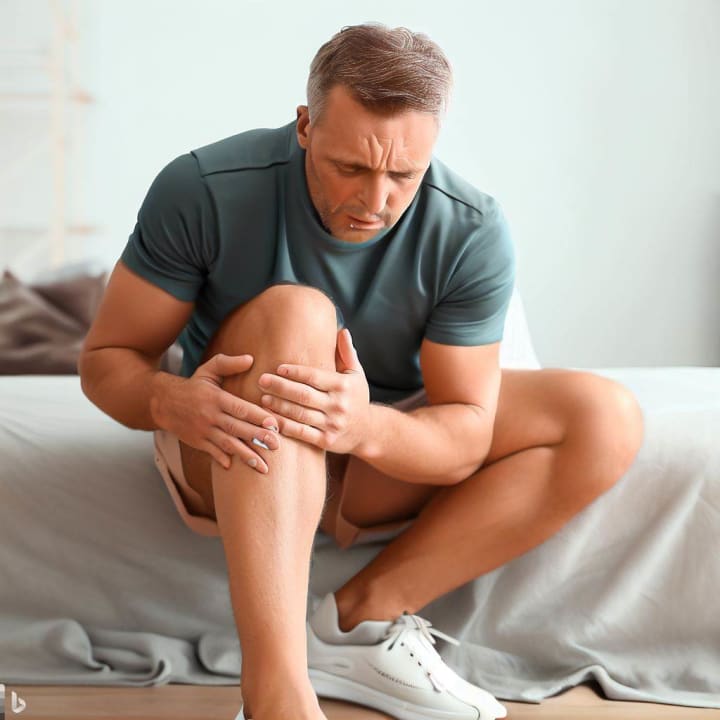Pain in Knee and Leg
Causes, Symptoms, and Treatment Options

Knee and leg pain is a common ailment that can affect people of all ages and lifestyles. It can be caused by various factors, such as injuries, medical conditions, or overuse. The discomfort can range from mild to severe, and it can affect one or both legs. In this article, we will discuss the causes, symptoms, and treatment options for knee and leg pain.
Introduction
Knee and leg pain can interfere with daily activities and significantly impact a person's quality of life. It is essential to understand the causes and treatment options for this type of pain to alleviate discomfort and prevent further complications.
Anatomy of the Knee and Leg
Before delving into the causes and symptoms of knee and leg pain, it is crucial to understand the anatomy of the knee and leg. The knee is the largest joint in the body and is made up of bones, cartilage, ligaments, and tendons. The leg is comprised of three bones: the femur, tibia, and fibula. The femur is the thigh bone, while the tibia and fibula make up the shin bone.

Common Causes of Knee and Leg Pain
Knee and leg pain can be caused by various factors, including injuries, arthritis, overuse, and medical conditions.
Injuries
Injuries are a common cause of knee and leg pain. They can occur due to trauma, accidents, or sports-related activities. Common injuries that can cause knee and leg pain include:
ACL tear
Meniscus tear
Fractures
Sprains and strains
Tendinitis
Arthritis
Arthritis is a condition that causes inflammation in the joints. It can affect the knee and leg joints and cause pain, stiffness, and swelling. The two most common types of arthritis that affect the knee and leg joints are:
Rheumatoid arthritis
Overuse
Overuse can cause knee and leg pain, especially in people who engage in repetitive activities that strain the knee and leg muscles. Some of the common overuse injuries include:
Patellofemoral pain syndrome
Shin splints
IT band syndrome
Medical Conditions
Certain medical conditions can cause knee and leg pain, such as:
Gout
Varicose veins
Deep vein thrombosis
Cancer

Symptoms of Knee and Leg Pain
The symptoms of knee and leg pain can vary depending on the underlying cause. Some common symptoms include:
Pain, tenderness, and swelling in the knee or leg
Stiffness in the knee or leg joint
Limited range of motion
Redness or warmth in the affected area
Numbness or tingling sensation in the knee or leg
Diagnosis of Knee and Leg Pain
To diagnose the underlying cause of knee and leg pain, a doctor may perform various tests, such as:
X-rays
CT scan
MRI
Blood tests
Ultrasound

Treatment Options for Knee and Leg Pain
The treatment options for knee and leg pain depend on the underlying cause and severity of the condition. Some of the common treatment options include:
Rest and Ice
If the pain is caused by a minor injury or overuse, rest and ice may help alleviate the discomfort. Applying ice to the affected area for 15-20 minutes several times a day can reduce swelling and inflammation. Resting the affected leg can also help the muscles and joints recover.
Physical Therapy
Physical therapy can help strengthen the muscles and improve flexibility in the knee and leg joints. A physical therapist can recommend exercises and stretches to alleviate pain and improve mobility.
Medications
Medications can help alleviate pain and inflammation in the knee and leg joints. Some common medications used to treat knee and leg pain include:
Nonsteroidal anti-inflammatory drugs (NSAIDs)
Acetaminophen
Corticosteroids
Surgery
In severe cases, surgery may be necessary to alleviate knee and leg pain. Some common surgical procedures include knee replacement surgery, arthroscopy, and ligament repair.
Prevention of Knee and Leg Pain
Taking preventative measures can reduce the risk of developing knee and leg pain. Some preventative measures include:
Wearing appropriate footwear
Stretching before and after exercise
Engaging in low-impact exercises
Maintaining a healthy weight
Avoiding repetitive activities that strain the knee and leg muscles
How regular exercise affect knee pain
Regular exercise can have a significant impact on knee pain. While it may seem counterintuitive, engaging in physical activity can help alleviate knee pain and prevent further complications.
When a person exercises, it helps strengthen the muscles around the knee joint, which can help support the joint and alleviate pain. Stronger muscles also improve overall mobility and reduce the risk of injury or overuse.
Low-impact exercises, such as swimming, cycling, or walking, can be particularly beneficial for individuals with knee pain. These exercises are less likely to place undue stress on the knee joint and can help improve overall fitness and flexibility.
Stretching before and after exercise can also help alleviate knee pain. Stretching can help warm up the muscles and joints and improve mobility. It can also help prevent injuries or overuse.
It is essential to start slowly and gradually increase the intensity and duration of exercise. Overexertion can worsen knee pain and increase the risk of injury. It is also crucial to listen to the body and stop exercising if there is pain or discomfort.
In summary, regular exercise can have a positive impact on knee pain. Engaging in low-impact exercises, stretching, and gradually increasing exercise intensity can help alleviate pain and improve overall mobility and fitness. It is essential to start slowly, listen to the body, and seek medical attention if knee pain persists or worsens.
Too much exercise and knee pain
While regular exercise can have a positive impact on knee pain, overdoing it can actually worsen the pain and cause further complications. In some cases, too much exercise can lead to conditions such as runner's knee, which can cause significant pain and discomfort.
Overexertion can place undue stress on the knee joint, causing it to become inflamed and painful. This inflammation can lead to further complications and may require medical attention to alleviate.
Individuals who experience knee pain after exercising should take a break and allow the knee to rest. Ice and anti-inflammatory medications may also be helpful in reducing pain and inflammation.
It is also important to modify exercise routines and engage in low-impact activities that place less stress on the knee joint. Consulting with a physical therapist or healthcare provider can help develop an exercise plan that is safe and effective for individuals with knee pain.
In summary, too much exercise can worsen knee pain and cause further complications. Individuals experiencing knee pain should take a break, rest, and modify their exercise routines. Consulting with a healthcare provider can help develop an exercise plan that is safe and effective for individuals with knee pain.
When to See a Doctor
If the knee and leg pain persist despite rest and at-home treatment, it is essential to seek medical attention. It is also crucial to seek medical attention if there are signs of infection, such as fever, chills, or redness and warmth in the affected area.
Conclusion
Knee and leg pain can significantly impact a person's quality of life. Understanding the underlying causes and treatment options can help alleviate discomfort and prevent further complications. It is essential to seek medical attention if the pain persists or worsens.
FAQs
What are some common causes of knee and leg pain?
Some common causes of knee and leg pain include injuries, arthritis, overuse, and medical conditions.
What are the symptoms of knee and leg pain?
The symptoms of knee and leg pain can vary, but some common symptoms include pain, tenderness, swelling, stiffness, and a limited range of motion.
How is knee or leg pain diagnosed?
To diagnose knee and leg pain, a doctor may perform various tests, such as X-rays, CT scans, MRIs, blood tests, or ultrasounds.
What are some treatment options for knee and leg pain?
Some common treatment options for knee and leg pain include rest and ice, physical therapy, medications, and surgery.
How can knee and leg pain be prevented?
Knee and leg pain can be prevented by wearing appropriate footwear, stretching before and after exercise, engaging in low-impact exercises, maintaining a healthy weight, and avoiding repetitive activities that strain the knee and leg muscles.
About the Creator
VitalityVibe
Welcome to VitalityVibe, your ultimate resource for unlocking your health potential and embracing a vibrant life. Our platform is designed to inspire and guide you on your journey to holistic well-being.






Comments
There are no comments for this story
Be the first to respond and start the conversation.